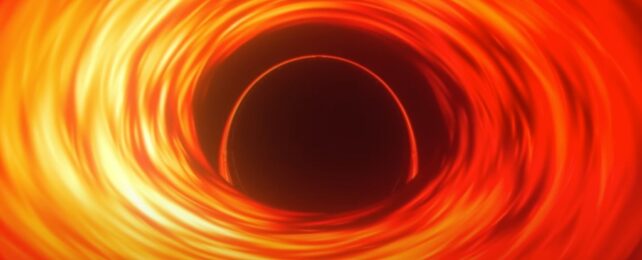NASA has dropped a new animation to give you a true sense of the amount of space dominated by a supermassive black hole.
These are the behemoths of the Universe; the colossi that sit at the centers of galaxies; the gravitational hearts around which stars whirl in an orbiting dance measured in eons. They start at around 100,000 times the mass of the Sun, on the lower end of the scale, and can reach tens of billions of solar masses at maximum.
These abstract numbers are all well and good, but it's hard to conceive just how huge these things actually are. And that's one of the big mysteries of the Universe: although we have some ideas, we just don't really know how they got that way.
"Direct measurements, many made with the help of the Hubble Space Telescope, confirm the presence of more than 100 supermassive black holes," says theoretical astrophysicist Jeremy Schnittman of NASA's Goddard Space Flight Center. "How do they get so big? When galaxies collide, their central black holes eventually may merge together too."
Actually, the black holes themselves may not be very big at all. Black holes are the densest objects that we know of in the Universe. They're so compact that we can only mathematically describe them as a singularity – a one-dimensional point of infinite density. So extreme is their density that space-time becomes gravitationally warped into what is effectively a closed sphere around them. Within that sphere, not even light has sufficient velocity to escape.
This is what we refer to when we talk about the dimensions of a black hole, its boundary known as the event horizon. The more massive the black hole, the larger the radius of the sphere defined by the event horizon, known as the Schwartzschild radius. If the Sun was a black hole, for instance, its Schwartzschild radius would be just 2.95 kilometers (1.8 miles).
As far as we know, the smallest black holes start at around five times the mass of the Sun, objects that have formed from the collapsed core of a massive star at the end of its life. These are stellar mass black holes.
Stellar mass black holes have an upper limit of around 65 times the mass of the Sun, because the extremely hefty precursor stars that would produce these larger objects end their lives in a pair-instability supernova that completely obliterates the core, leaving nothing behind to collapse into the black hole.
However, we've seen stellar mass black holes more massive than 65 solar masses. They can form when black holes collide and merge, resulting in an object with a combined mass. But how we get from these to the supermassive and ultramassive black holes is a big empty space. Quite literally. There is a curious dearth of detected black holes in the mass range between stellar mass black holes and supermassive ones.
But there's a huge range in supermassive black holes, too. NASA's new animation is a rather jaw-dropping look at that range, starting with a black hole in a dwarf galaxy named J1601+3113, which hosts a black hole around 100,000 solar masses. This would give it a Schwarzschild radius a little less than half the size of the Sun. The shadow of the black hole extends to the space around the event horizon, producing a darker region about twice its size, which means that, in the video, this shadow appears to be around the same size as the Sun.
We also see the supermassive black hole in the center of our own galaxy, Sagittarius A*, clocking in at around 4.3 million solar masses. There's also M87*, the first black hole ever imaged, which has a much higher mass of 5.37 billion Suns.
There are also two black holes that hang in the center of the same galaxy, NGC 7727. Once upon a time, NGC 7727 was two galaxies. Having now come together, the two black holes at the galactic cores – clocking in at 154 million and 6.3 million solar masses respectively – sank to the center of the newly combined galaxy, where one day they, too, shall merge.
These black holes are a big clue that astronomers think tell us one way in which supermassive black holes grow, and their mergers should produce gravitational waves. However, the frequency of these mergers is too low for our current instruments to detect.
One of the largest black holes we know of in the Universe is a beast known as TON-618. In 2004, scientists measured its mass to a whopping 66 billion solar masses. One theoretical upper mass limit for black holes is around 50 billion solar masses, but the Universe is pretty good at defying theoretical predictions.
At that mass, the black hole would have a Schwarzschild radius of over 1,300 astronomical units. For context, Pluto has an orbit that sits around 40 astronomical units from the Sun. This thing would engulf the Solar System hundreds of times over.
Luckily it's very far away; its light is estimated to be 10.8 billion years old, so it's not going to be lurking around doing any engulfing in our corner of space. We think we speak for everyone when we say, resoundingly: Phew.
